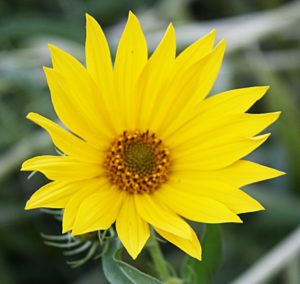The beginning of October my Maximilian’s Daisy (Helianthus maximiliani) was at peak

These sunflowers may be small compared to their annual cousin but they are still showy and attract pollinators, butterflies, and birds.
bloom. This sunflower, native to the Great Plains has bloomed reliably in my garden for a number of seasons and I don’t have plant it every year because it is perennial. In fact,
it increases in density every year giving me a prettier floral display than the previous year.
It has smaller flowers than most annual sunflowers and its flowers are arranged hollyhock style up and down the top 1/4 to 1/3 third of the stalk. The leaves are also smaller and narrower than most annual sunflowers but this plant is still in the same genus and all the other sunflowers.
The flowers are 3″ to 4″ in diameter with yellow rays and darker centers start to open in August. Flowering continues until the first frost in fall or sometime in October. This year the first frost to kill freeze these flowers didn’t come until about the third week in October.
Amazingly, it will do well in almost any garden condition from very dry to very wet. It is not picky about soil texture or pH either. However, you will want to give careful consideration when placing Maximilian’s daisy in your garden since it can reach 10 ft in height. It also spreads out but is not an aggressive invader.
A good place for Maximilian’s daisy is to plant it along fences to prop up sagging branches. In addition, when planted against a fence, the mass of flowers it produces is less likely to obscure some other features in your garden. Plant Maximilian’s daisy with tall grasses or for more color plant perennial blue salvia in front of them.
Maximilian’s daisy works great to control erosion on larger properties with erodible soils. The dense rhizomatous mass at the base of these sunflowers does an excellent job of holding soil in place.
If you want to attract wildlife to your yard, Maximilian’s daisy will do that as well. The seeds are a magnet for goldfinches in the fall. Monarch butterflies feed on the nectars produced by this sunflower. Deer will also graze this plant but only in the late fall when other types of forage are no longer green and the stalks of this daisy are still green. However, the deer do little damage to this plant since next year the new shoots will sprout undamaged by deer and probably remain so until late in the season.
You can purchase seed of Maximilian’s daisy from many native seed companies and even a few companies that don’t specialize in native seeds. Seeds of Maximilian’s daisy doesn’t as easily as annual sunflowers but still will germinate without any treatment. I usually germinate my Maximilian’s daisies in my greenhouse and transplant them to the garden in spring.
Once Maximilian’s daisy has germinated, it becomes an easy plant to establish and maintain. Some of the newly established plants will bloom the first summer but otherwise, it takes a second year of growth to see many flowers on this sunflower. As the years go by the number of stalks from a single plant will increase every year and you will have a mass of sunflowers from one plant. Some seed will also germinate from spent flowers in previous years.
Maximilian’s Daisy does not require a lot of water but more water will increase the height the plant. If you live in the arid western United States, expect to water Maximilian’s Daisy deeply at least once a week. Other regions of the country may not need to water this plant. If planted in a location with an abundance of soil moisture, Maximilian’s daisy stalks will likely grow to be 10 ft plus and need staking.
In winter, cut the dry stalks down to make way for new shoots. New stalks will spring from the clump of rhizomes at the base of the dead stalks.
Not many pests ruin your display of Maximilian Daisies and they will come up year after year with no effort on your part.


